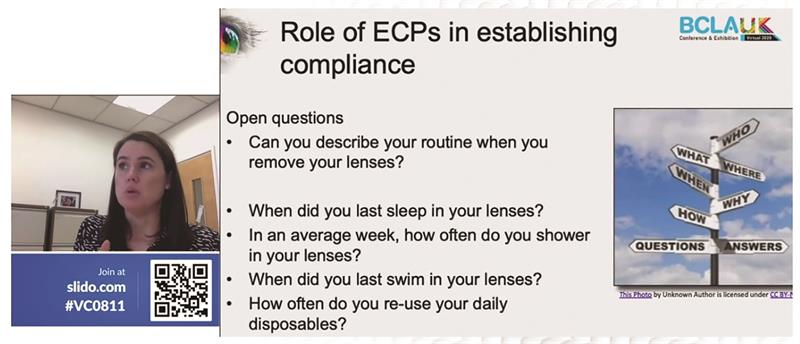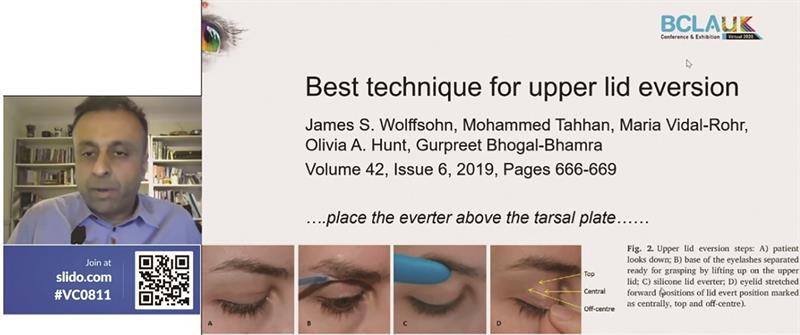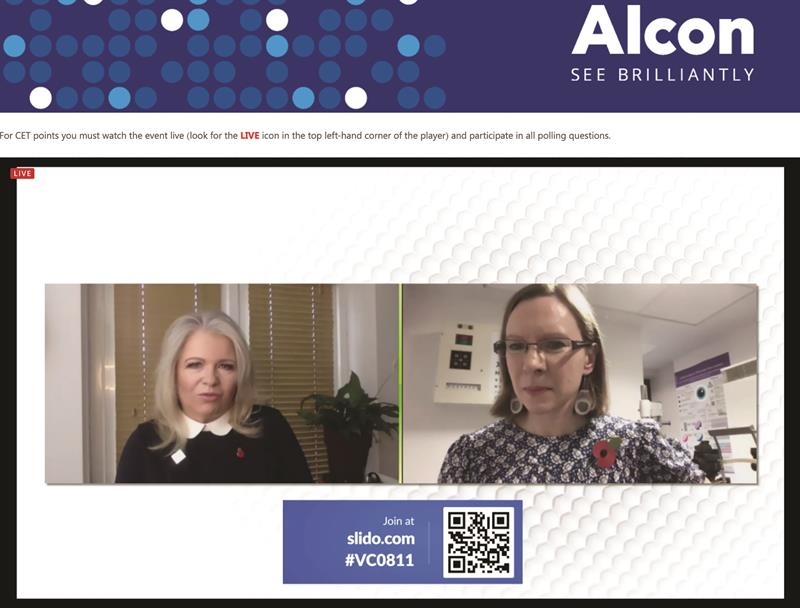
Of the various conferences and events populating an eye care practitioner’s calendar, the British Contact Lens Association (BCLA) conference has to be one of the most important. So, it was reassuring that some of the disappointment of cancelled live events was ameliorated by an excellent online virtual event. The BCLA Virtual Conference and Exhibition allowed practitioners from around the world an opportunity to hear of the latest science influencing contact lens and anterior eye practice and succeeded in being both relevant and up to date.
Prescribing
Professor Phil Morgan (Manchester University) kicked off a useful session looking at prescribing habits, including changes brought about by the pandemic, with a summary of his excellent work identifying patterns of contact lens prescribing over recent years, as is periodically published in his ‘trends’ articles for Optician. His figures always throw up new points of interest. For example, orthokeratology and myopia management are starting to show increased fitting of both rigid gas permeable (RGP) and multifocal soft lenses, and the predicted demise of RGPs is unlikely now to happen after all. The mean age of fitting in the UK is increasing, presumably due to better options for presbyopia, but is generally in the over 30s for most countries; something that is likely to change with paediatric fitting becoming more common. The uptake of daily disposables is well known to have increased, but there is also increased acceptance of silicone hydrogel dailies. Despite an increase in soft toric fits, the numbers do not, as yet, reflect the predicted number of patients for whom these lenses would be beneficial.
The theme was continued by Paul York (senior account manager at GfK) who looked at commercial considerations and who began by showing how, during the credit crunch of the late noughties, contact lens revenues were particularly stable; something of obvious relevance today. He also noted that the share of daily lenses had grown significantly from 2015 and was set to overtake reusable lens volume ‘imminently’. In 2019, the percentage of contact lens sales for multifocals, despite continuing growth over the past decade, was still at 7.1%, representing an obvious opportunity for future sales growth. York also noted that, though there had been a decline in contact lens sales since Covid-19 hit, this had been nothing like the drop-in appointments and hinted that this may reflect how we undertake our clinical practice in future.
This was taken up by Zoe Bull (CooperVision) who looked at ways of ‘reigniting your contact lens practice.’ She noted how the most significant drops in contact lens practice had been in more southerly, Mediterranean countries, with much lower impact in the UK and US. She also described how patients were reporting less wearing of their lenses, despite all the good work coming out of centres such as the Centre for Ocular Research and Education (Core) team at Waterloo University showing there to be no increased risk of concerns resulting from contact lens use during the pandemic. While 80% of wearers wanted more online access to practitioners, only 29% of practitioners had plans to continue online supply in the future. Some 30% of remote consultations are related to contact lens issues, but only 37% practitioners suggested they might continue these in future. One impressive finding from Bull’s work shows that an impressive 53% of people currently wanting contact lenses cited ‘avoiding my glasses fogging up’ as the main reason (figure 1); surely an opportunity out of a crisis?
Compliance
The always interesting Dr Katharine Evans (Cardiff University) and independent prescribing practitioner Sarah Farrant delivered an excellent discussion on compliance. Evans cited a recent Spanish paper that stated, despite a background of reduced contact lens wear since the pandemic began, a sobering 90% had had no contact from their eye care practitioner (ECP) and only 20% had contacted their ECP about any problem. I hope, as we all get more accustomed to online consultation, this is a short-term blip. There is also evidence of poorer compliance with instructions for safe use of reusable contact lenses in recent months. Water exposure is still a big problem and research has suggested that, in the UK, only 20% of people wash their hands correctly. Finally, the accuracy of compliance predictions may be inaccurate as people may not tell the truth when surveyed (figure 2), suggesting the figures may be even worse. To avoid this, Evans suggested, we should always use open questions when assessing compliance.
 Figure 3: Do patients tell the truth about their contact lens regime?
Figure 3: Do patients tell the truth about their contact lens regime?
Stick to the Evidence
The importance of good information supported by the evidence base has never been so essential as at present. A session themed around this began with an excellent opportunity, well taken by Dr Shehzad Naroo, to highlight some papers of note published in the well-respected BCLA journal Contact Lenses and Anterior Eye, of which he is editor. These included a look at how tear ferning (see Optician 28.9.18) offers an new and useful approach to dry eye assessment, the discovery that meibomian glands of the lower lid were wider such that people with narrower gland ducts were less likely to successfully express meibum and suffer meibomian gland dysfunction, and a conclusion that there is one best way to evert the upper eye lid during aftercare (figure 3).
 Figure 3: The best way to evert the upper eyelid
Figure 3: The best way to evert the upper eyelid
After a speedy run through of the usefulness of apps and software in clinical practice from Drs Byki Huntjens and Manbir Nagra, there was an excellent
discussion from optometry polymath Professor James Wolffsohn (Aston University) of the various levels of evidence upon which knowledge base is established. This ranges from the purely anecdotal through to the ‘gold standard’ of the double blinded randomised control study design. Along the way, he offered some surprises such as the fact that the ‘20-20-20 rule’ we often discuss with our computer-viewing patients is not based on any evidence. With the constant bombardment of science results from vaccine trials offered by news outlets, this talk was essential listening.
After the session, an online poll confirmed that an optimistic 44% of delegates changed their mode of practice more than once a year based on the evidence base. It is thanks to events such as this that this is possible.
Sustainability in practice
Mike Hale reports
The pre-lunch session on the Digital Seminar Track, ‘Eyes On The Planet: Sustainability in Practice’, was presented by Sarah Smith, research optometrist at Eurolens Research, along with optometrist and communication expert Sarah Morgan.
In the opening section, Morgan promised to channel teen environmental activist Greta Thunberg and referred to the BBC natural history series Blue Planet II, which aired in 2017, as a tipping point in public perception of climate change and pollution. She also drew attention to the mobius recycling logo that is printed on consumer goods and went through the various numerical RIC codes that accompany it.
An interactive live poll asked the audience to identify the percentage of contact lens wearers in the USA that flushed their used contact lenses down the drain. The correct answer of 21% drew attention to the harm being caused by contact lenses disposed of in this manner. Morgan gave details of TerraCycle’s Acuvue Contact Lens Recycle Programme that operates in practices across the UK and said practitioners should attempt to identify people disposing of contact lenses improperly and change their behaviour.
The latter part of the session was presented by Smith, who painted a broad picture of international efforts to get to grips with climate change and degradation of the natural environment. She defined sustainable development as development that meets the needs of the present without compromising the ability of future generations to meet their own needs and emphasised that even a relatively small rise in temperature will likely have catastrophic consequences.
Focusing on how to make an optical practice more sustainable, Smith highlighted measures such as going paperless, switching to energy suppliers that use renewable sources, and recycling. She also emphasised the importance of having non-discriminatory work policies and offering flexible working if possible. In conclusion, Smith said these actions and others outlined can make a difference and that making an effort to be sustainable resonates with patients. The session finished with some questions from the audience.
 Figure 2: Sustainability session
Figure 2: Sustainability session
